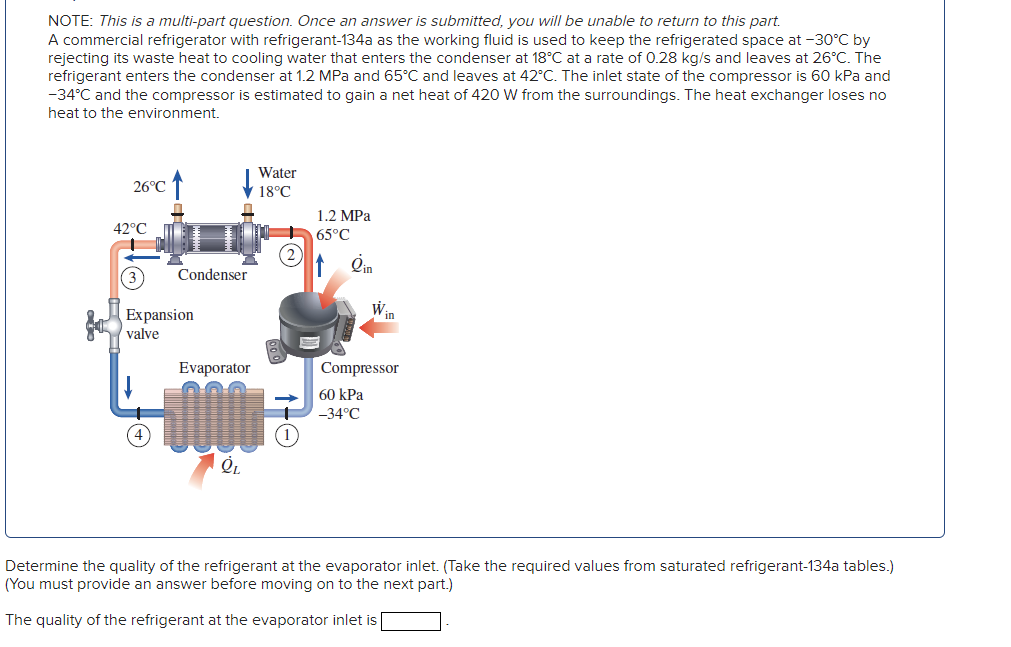NOTE: This is a multi-part question. Once an answer is submitted, you will be unable to return to this part. A commercial refrigerator with refrigerant-134a as the working fluid is used to keep the refrigerated space at -30°C by rejecting its waste heat to cooling water that enters the condenser at 18°C at a rate of 0.28 kg/s and leaves at 26°C. The refrigerant enters the condenser at 1.2 MPa and 65°C and leaves at 42°C. The inlet state of the compressor is 60 kPa and -34°C and the compressor is estimated to gain a net heat of 420 W from the surroundings. The heat exchanger loses no heat to the environment. 26°C↑ 42°C (3) Condenser Expansion valve Evaporator 1000 QL Water 18°C (2 1.2 MPa 65°C Compressor 60 kPa -34°C termine the quality of the refrigerant at the evaporator inlet. (Take the required values from saturated refrigerant-134a tables.) u must provide an answer before moving on to the next part.) e quality of the refrigerant at the evaporator inlet is [
NOTE: This is a multi-part question. Once an answer is submitted, you will be unable to return to this part. A commercial refrigerator with refrigerant-134a as the working fluid is used to keep the refrigerated space at -30°C by rejecting its waste heat to cooling water that enters the condenser at 18°C at a rate of 0.28 kg/s and leaves at 26°C. The refrigerant enters the condenser at 1.2 MPa and 65°C and leaves at 42°C. The inlet state of the compressor is 60 kPa and -34°C and the compressor is estimated to gain a net heat of 420 W from the surroundings. The heat exchanger loses no heat to the environment. 26°C↑ 42°C (3) Condenser Expansion valve Evaporator 1000 QL Water 18°C (2 1.2 MPa 65°C Compressor 60 kPa -34°C termine the quality of the refrigerant at the evaporator inlet. (Take the required values from saturated refrigerant-134a tables.) u must provide an answer before moving on to the next part.) e quality of the refrigerant at the evaporator inlet is [
Refrigeration and Air Conditioning Technology (MindTap Course List)
8th Edition
ISBN:9781305578296
Author:John Tomczyk, Eugene Silberstein, Bill Whitman, Bill Johnson
Publisher:John Tomczyk, Eugene Silberstein, Bill Whitman, Bill Johnson
Chapter45: Domestic Refrigerators And Freezers
Section: Chapter Questions
Problem 12RQ: Refrigerators currently being manufactured in the United States are using______as their refrigerant.
Related questions
Question

Transcribed Image Text:NOTE: This is a multi-part question. Once an answer is submitted, you will be unable to return to this part.
A commercial refrigerator with refrigerant-134a as the working fluid is used to keep the refrigerated space at -30°C by
rejecting its waste heat to cooling water that enters the condenser at 18°C at a rate of 0.28 kg/s and leaves at 26°C. The
refrigerant enters the condenser at 1.2 MPa and 65°C and leaves at 42°C. The inlet state of the compressor is 60 kPa and
-34°C and the compressor is estimated to gain a net heat of 420 W from the surroundings. The heat exchanger loses no
heat to the environment.
26°C
42°C
Expansion
valve
4
Condenser
↓
Evaporator
Water
18°C
QL
1.2 MPa
65°C
Qin
W
in
Compressor
60 kPa
-34°C
Determine the quality of the refrigerant at the evaporator inlet. (Take the required values from saturated refrigerant-134a tables.)
(You must provide an answer before moving on to the next part.)
The quality of the refrigerant at the evaporator inlet is
Expert Solution
This question has been solved!
Explore an expertly crafted, step-by-step solution for a thorough understanding of key concepts.
This is a popular solution!
Trending now
This is a popular solution!
Step by step
Solved in 3 steps with 7 images

Knowledge Booster
Learn more about
Need a deep-dive on the concept behind this application? Look no further. Learn more about this topic, mechanical-engineering and related others by exploring similar questions and additional content below.Recommended textbooks for you

Refrigeration and Air Conditioning Technology (Mi…
Mechanical Engineering
ISBN:
9781305578296
Author:
John Tomczyk, Eugene Silberstein, Bill Whitman, Bill Johnson
Publisher:
Cengage Learning

Refrigeration and Air Conditioning Technology (Mi…
Mechanical Engineering
ISBN:
9781305578296
Author:
John Tomczyk, Eugene Silberstein, Bill Whitman, Bill Johnson
Publisher:
Cengage Learning